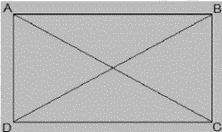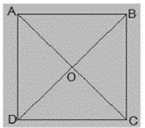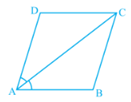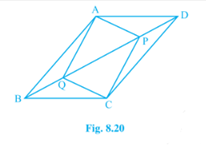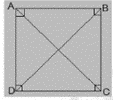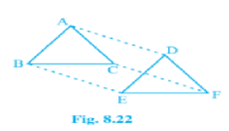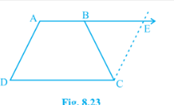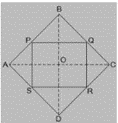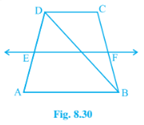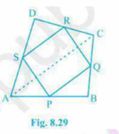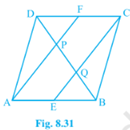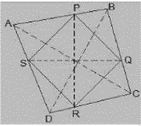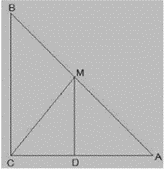Unacademy’s expert faculty created the NCERT Solutions for Class 9 Maths Chapter 8- Quadrilaterals. For the first term, these NCERT Maths Solutions assist students in solving problems deftly and swiftly. Faculty of Unacademy also focused on formulating the Maths Solutions in a way that students can understand easily.
The NCERT Solutions for Class 9 are designed to provide students with detailed, step-by-step explanations for all of the answers to the questions in this Chapter’s exercises. Students are introduced to a number of important topics in NCERT Solutions for Class 9 Maths Chapter 8 that are considered to be highly essential for those who choose to study Mathematics as a subject in their higher courses. Students can practise and prepare for their upcoming first term exams using these NCERT Solutions, as well as familiarise themselves with the fundamentals of Class 10. These NCERT Class 9 Maths Solutions are useful because they are prepared in accordance with the most recent update on the CBSE syllabus for 2022-23 and its guidelines.
NCERT Solutions for Class 9 Maths - Quadrilaterals PDF preview
Exercise – 8.1
Q.1. The angles of the quadrilateral are in the ratio 3 : 5 : 9 : 13. Find all the angles of the quadrilateral.
Solution:
Let us consider the common ratio between the angles be=x
And we know that the sum of the interior angles of quadrilateral is= 360^{0}
Now,
3x+5x+9x+13x=360^\circ \\
30x=360^{\circ}\\
x=12^{\circ}\\
\text{Angles of the Quadrilateral are:}\\
3x=3\times 12^{\circ}=36^{\circ}\\
5x=5\times 12^{\circ}=60^{\circ}\\
9x=9\times 12^{\circ}=108^{\circ}\\
13x=13\times 12^{\circ}=156^{\circ}\\
Q.2. If the diagonals of a parallelogram are equal, then show that it is a rectangle.
Answer:
According to the question,
AC=BD
To show that, ABCD is a rectangle if the Diagonals of a Parallelogram are Equal.
Now, to show ABCD is a rectangle we have to prove that one of its interior angles is right angled.
Proof:
In \triangle ABC \text{ and } \triangle BAD
AB=BA(Common)
BC=AD (Opposite Sides of A Parallelogram are equal)
AC=BD(Given)
Therefore, \triangle ABC\cong \triangle BAD [SSS Congruency]
\angle A=\angle B [Corresponding parts of Congruent Triangles
Also,
\angle A+\angle B=180^{0}\\
2\angle A=180^{0}\\
\angle A=90^{0}=\angle B\\
Therefore, ABCD is a Rectangle
Hence Proved.
Q.3. Show that if the diagonals of a quadrilateral bisect each other at right angles, then it is a rhombus.
Answer:
Let ABCD be a Quadrilateral whose Diagonals bisect each other at right angles.
Given in the Question,
OA=OC
OB=OD
And \angle AOB=\angle BOC=\angle OCD=\angle ODA=90^{0}
To Show,
If the Diagonals of a Quadrilateral bisect each other at right angles, then it is a Rhombus. Hence, we have to Prove that ABCD is Parallelogram and AB=BC=CD=AD.
\text{In } \triangle AOB \text{ and } \triangle COB
OA=OC [Given]
\angle AOB=\angle COB (Opposite sides of a Parallelogram are Equal)
OB=OB[Common]
Therefore, \triangle AOB\cong \triangle COB [SAS Congruency]
Thus, AB=BC [CPCT]
Thus, we can prove that,
BC=CD
CD=AD
AD=AB
AB=BC=CD=AD
Opposite Sides of a Quadrilateral are equal hence ABCD is a Parallelogram.
Hence, ABCD is rhombus as it is a Parallelogram whose diagonals intersect at right angle.
Hence Proved.
Q.4. Show that the diagonals of a square are equal and bisect each other at right angles.
Answer:
Let us consider ABCD be a Square and its diagonals AC and BD intersect each other at O.
To Show that,
AC=BD
AO=OC
and \angle AOB=90^{0}
Proof:
\text{In } \triangle ABC \text{ and } \triangle BAD,
BC=BA[Common]
\angle ABC=\angle BAD=90^{0}
AC=AD[Given]
Therefore \triangle ABC \cong \triangle BAD [SAS Congruency]\\
Thus,
AC=BD [CPCT]
diagonals are equal.
Now,
\text{In } \triangle AOB \text{ and } \triangle COD,\\
\angle BAO=\angle DCO \text{ (Alternate interior Angles) }\\
\angle AOB= \angle COD \text{ (Vertically Opposite) }\\
AB=CD \text{ [Given] }\\
\triangle AOB \cong \triangle COD \text{ [AAS Congruency] }
Thus,
AO=CO[CPCT]
Diagonal bisect each other.
Now,
\text{In } \triangle AOB \text{ and } \triangle COB,\\
OB=OB \text{ [Given] }\\
AO=CO \text{ [Diagonals are Bisected] }\\
AB=CB \text{ [Sides of the Square] }
Hence,
\triangle AOB \cong \triangle COB \text{ [SSS Congruency] }\\
\text{Also, } \angle AOB=\angle COB\\
\angle AOB + \angle COB=180^{0}\\
\text{Thus, } \angle AOB=\angle COB=90^{0}
Hence, Diagonal bisect each other at right Angles.
Q.5. Show that if the diagonals of a quadrilateral are equal and bisect each other at right angles, then it is a square.
Answer:
Given in the Question,
Let us Consider ABCD to be a Quadrilateral and its diagonal AC and BD bisect each other at right angle at O.
To Prove,
The Quadrilateral ABCD is a Square.
Proof:
\text{In } \triangle AOB \text{ and } \triangle COD,\\
AO=CO 9 \text{ [Diagonal bisect each other] }\\
\angle AOB =\angle COD \text{ [Vertically Opposite] }\\
OB=OD \text{ [Diagonal bisect each other] }\\
\text{Hence, } \triangle AOB \cong \triangle COD \text{ [SAS Congruency] }
Thus,
AB=CD [CPCT]\to (i)\\
\text{Also, }\\
\angle OAB =\angle OCD \text{ [Alternate interior Angle] }\\
AB||CD\\
\text{Now,} \\
\text{In } \triangle AOD \text{ and } \triangle COD,\\
AO=CO \text{ [Diagonals Bisect each other] }\\
\angle AOD=\angle COD \text{ [Vertically Opposite] }\\
OD=OD \text{ [Common] }\\
\text{Hence, } \triangle AOD \cong \triangle COD \text{ [SAS Congruency] }\\
\text{Thus, }\\
AD=CD \text{ [CPCT] }\\
\text{Also, }\\
AD=BC \text{ and } AD=CD\\
\text{Also, } AD=BC=CD=AB \to (iii)\\
\text{Also,}\\
\angle ADC=\angle BCD \text{ [CPCT] }\\
\text{And } \angle ADC + \angle BCD=180^{0}\\
2\angle ADC=180^{0}\\
\angle ADC=90^{0}\to (iv)
Hence, one of the Interior Angle is Right angle.
Thus From (i), (ii) and (iii) given Quadrilateral ABCD is a Square.
Hence Proved.
Q.6. Diagonal AC of a parallelogram ABCD bisects ∠ A (see Fig. 8.19). Show that
(i) it bisects ∠ C also,
(ii) ABCD is a rhombus.
Solution:
(i) \text{In } \triangle ADC \text{ and } \triangle CBA\\,
AD=CB \text{ [Opposite sides of a Parallelogram] }\\
DC=BA \text{ [Opposite Sides of a Parallelogram] }\\
AC=CA \text{ [Common Side] }\\
\text{Hence, }\triangle ADC \cong \triangle CBA \text{ [SSS Congruency] }\\
\text{Thus, }
\angle ACD=\angle CAB \text{ by CPCT }\\
\text{And } \angle CAB= \angle CAD \text{ [Given] }\\
\angle ACD=\angle BCA\\
\text{Thus, }
AC \text{ bisect } \angle C \text{ also. }
(ii) \angle ACD =\angle CAD \text{ [proved Above] }\\
AD=CD \text{ [Opposite sides of a equal angle of a triangle are equal] }\\
AB=BC=CD=DA \text{ [Opposite Sides of a Parallelogram] }
Thus, ABCD IS Rhombus.
Q.7. ABCD is a rhombus. Show that diagonal AC bisects ∠ A as well as ∠ C and diagonal BD, bisects ∠ B as well as ∠ D.
Answer:
Given That in the Question
ABCD is a Rhombus.
AC and BD are its Diagonals.
Proof.
AD=CD \text{ [Sides of a rhombus] }\\
\angle DAC=\angle DCA \text{ [Angles opposite of equal sides of a Triangle are Equal] }\\
\text{Also, }\\
AB||CD\\
\angle DAC=\angle BCA \text{ [Alternate Interior Angle] }\\
\Rightarrow \angle DAC=\angle BCA\\
\text{Hence, } AC \text{ bisects } \angle C.\\
\text{Similarly}
We can prove that Diagonal Bisects.
Hence Proved.
Q.8. ABCD is a rectangle in which diagonal AC bisects ∠ A as well as ∠ C. Show that:
(i) ABCD is a square (ii) diagonal BD bisects ∠ B as well as ∠ D.
Answer:
(i) \angle DAC =\angle DCA\\
AD= CD \text{ [Sides opposite to equal angles of a triangle are equal] }\\
\text{Also, } CD=AB \text{ [Opposite Sides of a Rectangle] }\\
\text{Hence, } AB=BC=CD=AD\\
\text{Thus, ABCD is a Square }
(ii) \text{In }\triangle BCD\\
BC=CD\\
\angle CDB =\angle CBD \text{ [Angles opposite to equal sides are Equal] }\\
\text{Also, }\angle CDB=\angle ABD \text{ [Alternate interior Angle] }\\
\angle CBD=\angle ABD\\
\text{Thus, } BD \text{ bisects } \angle B\\
\text{Now, }\angle CBD= \angle ADB\\
\angle CDB =\angle ADB\\
\text{Thus, }BD \text{ bisects }\angle B \text{ as well as } \angle D.
Q.9. In parallelogram ABCD, two points P and Q are taken on diagonal BD such that DP = BQ (see Fig. 8.20). Show that:
(i) ∆ APD ≅ ∆ CQB
(ii) AP = CQ
(iii) ∆ AQB ≅∆ CPD
(iv) AQ = CP
(v) APCQ is a parallelogram
Answer:
(i) \text{In }\triangle APD \text{ and }\triangle CQB,\\
DP=BQ \text{ [Given] }\\
\angle ADP=\angle CBQ \text{ [Alternate Interior Angle] }\\
AD=BC\\
\text{Thus, }\triangle APD\cong \triangle CQB \text{ [SAS Congruency] }
(ii) AP=CQ \text{ by CPCT as }\triangle APD \cong \triangle CQB.
(iii) \text{In }\triangle AQB \text{ and } \triangle CPD,\\
BQ=DP \text{ [Given]} \\
\angle ABQ= \angle CDP \text{ [Alternate Interior Angle] }\\
AB=CD\\
\text{Thus, }\triangle AQB\cong \triangle CPD \text{ [SAS Congruency] }
(iv) \text{As }\triangle AQB \cong \triangle CPD\\
AQ=CP \text{ [CPCT] }
(v) From (ii) and (iv) it is clear that APCQ has equal opposite sides and also has equal and opposite Angles.
Hence, APCQ is a Parallelogram.
Q.10. ABCD is a parallelogram and AP and CQ are perpendiculars from vertices A and C on diagonal
BD (see Figure). Show that
(i) ∆ APB ≅ ∆ CQD
(ii) AP = CQ
Answer:
(i) \text{In } \triangle APB \text{ and }\triangle CQD,\\
\angle ABP=\angle CDQ \text{ [Alternate interior Angles] }\\
\angle APB =\angle CQD=90^{0} \text{ [as AP and CQ are Perpendiculars] }\\
AB=CD \text{ [ABCD is a Parallelogram] }\\
\text{Hence, }\triangle APB \cong \triangle CQA \text{ [AAS Congruency] }
(ii) \text{As }\triangle APB \cong \triangle CQD\\ \text{Therefore, }AP=CQ \text{ [CPCT] }
Q.11. In ∆ ABC and ∆ DEF, AB = DE, AB || DE, BC = EF and BC || EF. Vertices A, B and C are joined to
vertices D, E and F respectively (see Fig. 8.22).
Show that
(i) quadrilateral ABED is a parallelogram
(ii) quadrilateral BEFC is a parallelogram
(iii) AD || CF and AD = CF
(iv) quadrilateral ACFD is a parallelogram
(v) AC = DF
(vi) ∆ ABC ≅ ∆ DEF.
Solution:
AB=DE and AB||DE [Given]
Two opposite sides of a Quadrilateral are the same and parallel to each other.
Thus, Quadrilateral ABED is a Parallelogram.
Again BC=EF and BC||EF.
Thus, Quadrilateral BECF is Parallelogram.
Since ABED and BEFC are Parallelogram.
AD=BE and BE=CF [Opposite sides of a Parallelogram are Same]
Hence, AD=CF.
Also, AD||BE and BE||CF (Opposite Sides of a Parallelogram are Parallel)
AD and CF are Opposite sides of Quadrilateral ACFD which are Same and Parallel to each Other. Thus it is a Parallelogram.
Since ACFD is a Parallelogram
AC||DF and AC=DF.
(vi) \text{In }\triangle ABC \text{ and }\triangle DEF,\\ AB=DE \text{ [Given] }\\ BC=EF \text{ [Given] }\\ AC=DF \text{ [Opposite sides of a Parallelogram] }\\ \text{Hence, }\triangle ABC \cong \triangle DEF \text{ [SSS Congruency] }
Q.12. ABCD is a trapezium in which AB || CD and
AD = BC (see Fig. 8.23). Show that
(i) ∠ A = ∠ B
(ii) ∠ C = ∠ D
(iii) ∆ ABC ≅ ∆ BAD
(iv) diagonal AC = diagonal BD
[Hint: Extend AB and draw a line through C parallel to DA intersecting AB produced at E.]
Solution:
To Construct: Draw a line through C Parallel to DA intersecting AB Produce at E.
(i) CE=AD \text{ [Opposite sides of a Parallelogram] } \\
AD=BC \text{ [Given] }\\
BC=CE\\
\angle CBE = \angle CEB\\
\text{Also, } \angle A + \angle CBE=180^{0}\\
\angle B+\angle CBE=180^{0} \text{ [As Linear pair] }
(ii) \angle A +\angle D = \angle B+\angle C=180^{0}\\
\angle A+\angle D=\angle A+\angle C (\angle A=\angle B)\\
\angle D=\angle C
(iii) \text{In }\triangle ABC \text{ and } \triangle BAD,\\
AB=AB \text{ [Common] }\\
\angle DAB=\angle CBA\\
AD=BC \text{ (Given) }\\
\text{Therefore, }\triangle ABC \cong \triangle BAD \text{ [SAS Congruency] }
(iv) \text{Diagonal AC } = \text{ Diagonal BD by CPCT as }\triangle ABC \cong \triangle BAD.
Exercise 8.2
Q.1. ABCD is a quadrilateral in which P, Q, R and S are mid-points of the sides AB, BC, CD and DA
(see Fig 8.29). AC is a diagonal. Show that :
(i) SR || AC and SR=1/2 AC
(ii) PQ = SR
(iii) PQRS is a parallelogram.
Solution:
(i) \text{In }\triangle DAC,\\
\text{R is the mid-point of DC and S is the mid-point of DA.}\\
\text{Thus, by mid-point theorem, SR||AC and }SR=\frac{1}{2}AC.
(ii) \text{In }\triangle BAC,\\
\text{P is the mid-point of AB and Q is the Mid-point of BC. }\\
\text{Thus, by mid-point theorem, PQ||AC and } PQ=\frac{1}{2} AC\\
\text{Therefore, }PQ=SR
(iii) SR||AC \rightarrow \text{ from question (i) }\\ \text{And }PQ||AC\rightarrow \text{ from question (ii) }\\ \text{Hence, SR||PQ-from (i) and (ii)}\\ \text{Also, } PQ=SR\\ \text{Hence, PQRS is a Parallelogram. }
Q.2. ABCD is a rhombus and P, Q, R and S are the mid-points of the sides AB, BC, CD and DA respectively. Show that the quadrilateral PQRS is a rectangle.
Solution:
Given in the Question,
ABCD is a Rhombus and P,Q,R and S are the mid-points for the sides AB,BC,CD and DA Respectively.
To Prove,
PQRS is a Rectangle.
Construction,
Join AC and BD.
Proof:
\text{In }\triangle DRS \text{ and } \triangle BPQ,\\
DS=BQ \text{ (Halves of the opposite side of the Rhombus) }\\
\angle SDR=\angle QBP \text{ (Opposite angles of the Rhombus)}\\
DR=BP\\
\text{Hence, }\triangle DRS \cong \triangle BPQ, \text{ [SAS Congruency] }\\
RS=PQ \text{ [CPCT] }\rightarrow (i)\\
\text{In } \triangle QCR \text{ and } \triangle SAP,\\
RC=PA \text{ (Halves of the opposite sides of the rhombus) }\\
\angle RCQ= \angle PAS \text{ (Opposite angles of the rhombus) }\\
CQ=AS\\
\text{Hence, }\triangle QCR \cong \triangle SAP \text{ [SAS Congruency }\\
RQ=SP [CPCT]\rightarrow (ii)\\
\text{Now, }\\
\text{In }\triangle CDB,\\
\text{R and Q are the mid-points of CD and BC respectively. }\\
\text{Hence,} QR||BD\\
\text{Also, }\\
\text{Given that P and S are the mid-points of AD and AB respectively.}\\
PS||BD\\
QR||PS\\
\text{Hence, PQRS is a Parallelogram.}\\
\text{Also, } \angle PQR=90^{0}\\
\text{Now, }\\
\text{In PQRS,}\\
\text{RS=PQ and RQ=SP from (i) and (ii) }\\
\angle Q=90^{0}\\
\text{Hence, PQRS is a Rectangle. }
Q.3. ABCD is a rectangle and P, Q, R and S are mid-points of the sides AB, BC, CD and DA respectively. Show that the quadrilateral PQRS is a rhombus.
Answer
Given that,
ABCD is a rectangle and P,Q,R and S are the mid-points of the sides AB,BC,CD and DA respectively.
Construction
Join AC and BD.
To Prove,
PQRS is a rhombus.
Proof:
\text{In }\triangle ABC
\text{P and Q are the Mid-points of AB and BC respectively. }\\
PQ||AC and PQ=\frac{1}{2}AC \text{ (Midpoint Theorem) }\rightarrow (i)\\
\text{In } \triangle ADC,\\
SR||AC \text{ and } SR=\frac{1}{2}AC \text{ (Midpoint Theorem) }\rightarrow (ii)\\
\text{So, } PQ||SR \text{ and } PQ=SR\\
\text{ AS in Quadrilateral PQRS one pair of Opposite sides is equal and parallel to each other, so it is a parallelogram.}\\
\text{Therefore PS||QR and PS=QR (Opposite sides of Parallelogram) }\rightarrow (iii)\\
\text{Now, }\\
\text{In } \triangle BCD,\\
\text{Q and R are the Mid-points of side BC and CD respectively. }\\
QR||BD \text{ and } QR||\frac{1}{2}BD \text{ (Mid-point Theorem) }\rightarrow (iv)\\
AC=BD \text{ (Diagonals of a rectangle are equal) }\rightarrow (v)\\
\text{ Now from equation (i),(ii),(iii),(iv) and (v), } \\
PQ=QR=SR=PS\\
\text{Hence, PQRS is Rhombus.}\\
\text{Hence Proved }
Q.4. ABCD is a trapezium in which AB || DC, BD is a diagonal and E is the mid-point of AD. A line is drawn through E parallel to AB intersecting BC at F (see Fig. 8.30). Show that F is the mid-point of BC.
Solution:
Given That,
ABCD is a Trapezium in which AB||DC, BD is a Diagonal and E is the mid-point of AD.
To Prove,
F is the Mid-point of BC.
Proof,
\text{BD intersected EF at G.}\\
\text{In }\triangle BAD,\\
\text{E is the mid-point of AD and also EG||AB.}\\
\text{Thus, G is the mid-point of BD (Converse of mid-point theorem)}\\
\text{Now, }\\
\text{In } \triangle BDC,\\
\text {G is the mid-point of BD and also GF||AB||DC. }\\
\text{ Thus, F is the mid-point of BC (Converse of mid-point Theorem) }
Q.5. In a parallelogram ABCD, E and F are the mid-points of sides AB and CD respectively (see Fig. 8.31). Show that the line segments AF and EC trisect the diagonal BD.
Solution:
Given that,
ABCD is a Parallelogram. E and F are the mid-points of Sides AB and CD respectively.
To Show,
AF and EC trisect the Diagonal BD.
Proof,
ABCD is a Parallelogram.
Hence, AB||CD
Also, AE||FC
Now,
AB=CD \text{ (Opposite Sides of Parallelogram ABCD) }\\
\frac{1}{2} AB=\frac{1}{2} CD\\
AE=FC\\
\text{AECF is a Parallelogram (AE and CF are parallel and equal to each other) }\\
\text{AF||EC (Opposite sides of a parallelogram)}\\
\text{Now, }\\
\text{In }\triangle DQC,\\
\text{F is mid point of side DC and FP||CQ}\\
\text{P is the mid-point of DQ }\\
DP=PQ\rightarrow (i)\\
\text{Similarly, }\\
\text{In }\triangle APB,\\
\text{E is mid-point of side AB and EQ||AP.}\\
\text{ Q is the mid-point of PB(Converse of mid-point theorem)}\\
PQ=QB\rightarrow (ii)\\
\text{ From equation (i) and (ii) }\\
DP=PQ=BQ\\
\text{Hence, the line segments AF and EC trisect the Diagonal BD.}
Q.6. Show that the line segments joining the mid-points of the opposite sides of a quadrilateral bisect each other.
Solution:
Let us Consider ABCD be a Quadrilateral and P,Q,R and S are the mid-points of AB, BC,CD and DA respectively.
Now,
\text{In }\triangle ACD,\\
\text{ R and S are the points of CD and DA Respectively.}\\
\text{Hence, }SR||AC,\\
\text{Similarly we can show that}\\
PQ||AC,\\
PS||BD \text{ and }\\
QR||BD\\
\text{Hence, PQRS is a Parallelogram.}\\
\text{PR and QS are the diagonals of the parallelogram PQRS. So, they will bisect each other.}
Q.7. ABC is a triangle right angled at C. A line through the mid-point M of hypotenuse AB and parallel to BC intersects AC at D. Show that
(i) D is the mid-point of AC (ii) MD ⊥AC
(iii) CM = MA =1/2 AB.
Solution:
\text{In }\triangle ACB,\\
\text{M is the mid-point of AB and MD||BC}\\
\text{D is the mid-point of AC. (Converse of Mid-point Theorem)}
(ii) \angle ACB= \angle ADM \text{ (Corresponding Angles) }\\ \text{Also }\angle ACB=90^{0}\\ \text{Hence, }\angle ADM=90^{0} and MD \perp AC
(iii) \text{In }\triangle AMD \text{ and }\triangle CMD,\\ AD=CD \text{ (D is the mid point of AC) }\\ \angle ADM=\angle CDM (Each 90^{0})\\ DM=DM \text{ (Common) }\\ \text{Hence, }\triangle AMD\cong \triangle CMD \text{ [SAS Congruency] }\\ AM=CM \text{ [CPCT] }\\ \text{Also, }AM=\frac{1}{2} AB \text{ (M is the mid-point of Side AB) }\\ \text{Hence, }CM=MA=\frac{1}{2}AB.
 Profile
Profile Settings
Settings Refer your friends
Refer your friends Sign out
Sign out





